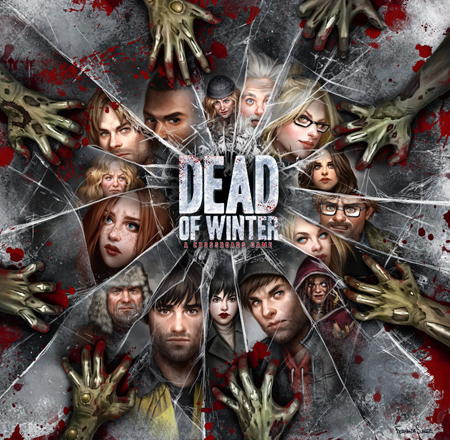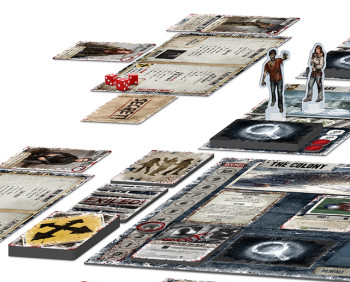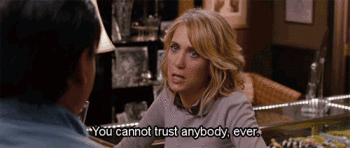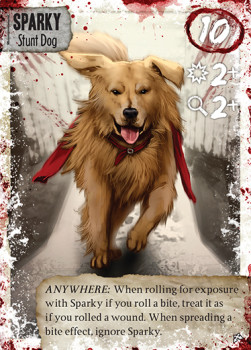Game Review: Dead of Winter from Plaid Hat Games
 Color me rotting-flesh green and call me thunderstruck. I believe I’ve been playing the best board game in my thirty years of dice rolling this week: the Plaid Hat Games survival horror magnificence that is Dead of Winter.
Color me rotting-flesh green and call me thunderstruck. I believe I’ve been playing the best board game in my thirty years of dice rolling this week: the Plaid Hat Games survival horror magnificence that is Dead of Winter.
Ron Burgundy “That’s No Lie” seal of approval. I know I often write here with tongue probing my cheek, but this time I’m undeadly serious. Maybe it was just the subject matter, or how dark the game can get as desperation builds, but I found it my most enjoyable gaming session in memory.
I’m not just trying to squeeze in another gore-dripped Zombie-related post before Halloween, either. I was perfectly willing to let my one sad little movie post for the month be my fall contribution, but honestly, this game has taken over my brain like a Venusian virus brought back to Earth and I must write about it.
Like tabletop gaming with friends? Like Zombies? If either of these conditions = TRUE, you can read through all my blah blah questionable-humor blah blah blah, or you can get off the Internet, utilize your preferred mode of transport (I don’t care about your hair, that’s why God created baseball hats), go to your Friendly Local Game Store and grab this jewel so you can read the rules and play it over the course of Halloween all the more quickly.
You’re welcome.
What, the word of a D-list author isn’t good enough for you? Okay, I enjoy the challenge of a reluctant conversion.
Ever wonder, at the end of a zombie movie, what happens to the survivors, often last seen heading for Canada like a bat outta hell? If you enjoy the same DSM-5 classifications as me, I’m sure you have. Dead of Winter answers that question. Not only does this group of survivors have to cope with zombies, they also need to survive harsh winter conditions. Of course the game doesn’t specify that it’s set in Canada, food cards show canned goods, not backbacon and Canadian Club. It could be Wyoming or Barrow, Alaska. Just really cold.
 The game gives you some nice art to depict your environs. There is a large “Colony” sheet laying out your stronghold and additional sheets give you graphics to resolve outcomes at a group of buildings in the unnamed town: a Hospital, Library, School, Grocery Store, Police Station, and Garage. All of these come with slots for placing your survivors and the zombies outside. Activity, like searching for food, weapons, or other survivors, causes zombies to accumulate. The Colony card is where you to track the rounds as they run out (like any good suspense movie, the clock is ticking) and the “morale” of your group. These are important, as the game can end in three ways: you run out of rounds, your morale drops to “0” and the colony disintegrates, or you complete the game objective. Oh, or everyone dies. Four ways.
The game gives you some nice art to depict your environs. There is a large “Colony” sheet laying out your stronghold and additional sheets give you graphics to resolve outcomes at a group of buildings in the unnamed town: a Hospital, Library, School, Grocery Store, Police Station, and Garage. All of these come with slots for placing your survivors and the zombies outside. Activity, like searching for food, weapons, or other survivors, causes zombies to accumulate. The Colony card is where you to track the rounds as they run out (like any good suspense movie, the clock is ticking) and the “morale” of your group. These are important, as the game can end in three ways: you run out of rounds, your morale drops to “0” and the colony disintegrates, or you complete the game objective. Oh, or everyone dies. Four ways.
The game offers a plethora of well-designed cards. There are character cards for your survivors, with nice, evocative art and a set of stats representing their importance to the colony (higher is better), fighting skill, and searching skill. Each survivor also brings a specific special ability that can either help the colony or that character survive. Emphasis on the “or.” The survivors are an intriguing bunch, everything from a Mall Santa (in what’s left of his costume) to a bitter old loner people call “Grey Beard.” I found the special abilities compelling. Unexpected people often proved to be essential survivors. In my first game, the school cook, Loretta, saved our growing colony from fatal morale loss through starvation with her ability to save and produce more food. You have to love a game design so elegant that the flippin’ lunch lady becomes the last hope of humanity. Though we lost our victory condition, our colony survived, and presumably Loretta trained an apprentice from among the dependents to carry on. And the spirit of Loretta is transferred across the Colony to a new cook and the power of the undead menace is contained for another generation and a new Lunch Lady is born to protect the next.
 In order to win the game, you must fulfill the conditions of the game colony objective card before time and morale runs out. The card has two sides, regular, and “hardcore” for experienced players. The conditions vary, but generally require the accumulation of a certain kind and amount of supplies or survivors. Each player also draws a “Secret” card with its own set of victory conditions. The only way for an individual player to truly “win” is to fulfill his secret. Most are fairly altruistic, like ensuring that the colony meets its victory condition with an extra frill or two. There is always a “betrayal” Secret card in the mix, which, if drawn, causes the player to work against the colony to fulfill the conditions of the Secret. The betrayer has his own peculiar motivations. Perhaps he believes that the struggle is futile and is sick of the effort and wants to die in true Götterdämmerung style, or maybe your survivor just thinks a bunch of pussies are running the show and he needs to take over. Either way, the game mechanics allow you to both betray the colony without revealing yourself, if you’re the baddie, and do detective work to figure out who is peeing in the colony’s precious supply of cornflakes.
In order to win the game, you must fulfill the conditions of the game colony objective card before time and morale runs out. The card has two sides, regular, and “hardcore” for experienced players. The conditions vary, but generally require the accumulation of a certain kind and amount of supplies or survivors. Each player also draws a “Secret” card with its own set of victory conditions. The only way for an individual player to truly “win” is to fulfill his secret. Most are fairly altruistic, like ensuring that the colony meets its victory condition with an extra frill or two. There is always a “betrayal” Secret card in the mix, which, if drawn, causes the player to work against the colony to fulfill the conditions of the Secret. The betrayer has his own peculiar motivations. Perhaps he believes that the struggle is futile and is sick of the effort and wants to die in true Götterdämmerung style, or maybe your survivor just thinks a bunch of pussies are running the show and he needs to take over. Either way, the game mechanics allow you to both betray the colony without revealing yourself, if you’re the baddie, and do detective work to figure out who is peeing in the colony’s precious supply of cornflakes.
The game mechanics are deceptively simple. The first thing the team does in a round is draw from yet another batch of cards, a “Crisis” card. The generator has unexpectedly run dry! You need more fuel! Like you don’t have enough problems already with the undead swarming about the doors. Each crisis in the Colony needs to be dealt with this round, or the Colony will suffer a setback — usually a loss of morale or more zombies piling up. These crises can be solved by throwing supplies at them, food, fuel, etc.
After that, you go to your player turn, in rotating order. The player rolls a number of traditional six-sided action dice equal to the survivors she controls plus one. Then she declares actions such as movement to a new location, searching, building barricades (an automatic success that even your most hapless character can perform, though it does use up an action die) or trying to destroy zombies at the entrances to the various locations. If enough zomibes accumulate, they force their way in and automatically kill people, lowest colony ranks first. She allocates the dice to her characters, to complete an action or an attack the die must be equal to or above the characters ability, thus a person with a search of 2 is superior to one with a 5. You are allowed to combine dice, so even if you roll poorly you can still usually complete a life-or-death action. I found the mechanic of allocating the actions post-roll odd at first, but you are just so much up-against-it in this game, it ends up being a Godsend.
More cards. There are also item cards representing food, weapons, tools, supplies, medicines, and equipment you can issue to your characters. You start out with a few. It is important that you keep them hidden, though you are allowed to trade them between players. More can also be gathered at the various locations outside the colony, and are cleverly organized so you’re more likely to find fuel at the gas station than at the library. You might also gather more survivor characters or dependents (“helpless characters” in game parlance, they do nothing for you but eat food and help meet certain victory conditions). Cards can be played at any time during your turn, as many as you like. Hand out medicine like candy to trick-or-treaters if you want–
Oh wait, there’s another set of cards, the most fun of all. These are the “Crossroads” cards. Every time a player begins his turn, the one next to him draws a secret Crossroads card. Thus you are occupied while your fellow player moves, as you have to see if any of his actions trigger the card. If the character triggers the Crossroads, it immediately goes into effect (like using those medical syringes of painkillers might get someone addicted. Hint: junkies hurt your colony’s chances of survival). Some of these are grimly humorous, others offer a potential boon at a calculated risk. For example, while a fellow player exploring the hospital, I had a crossroads card that triggered with a successful search of the hospital. In this case, a storage room with some fully-powered Rascal™ scooters was found. The player had a choice, either leave them sitting in the room or take them back to the colony and hold Rascal™ races. Holding Rascal™ races would improve the morale of the colony, but the noise would attract more zombies. Cute, fun decision point. Okay, some of the crossroads cards involve cannibalism and other mature themes (they’re marked so you can remove them if you’re playing with the kids, but I think kids into a zombie horror survival game might be less shockable than you think), so maybe more dark than cute and fun. Very dark. Bottom of a well during an eclipse dark. That being said, it’s a fascinating mechanism that turns the gaming experience into something very much like a movie with unexpected shocks.

At the end of the round you do colony housekeeping: eat food, see how much garbage has accumulated (yes, you have to do something with all those empty cans and medical waste or your colony’s morale decreases), and determine whether the crisis has been overcome or deal with the consequences of failure — this is where a betrayer can really throw sand in the colony’s gears. Sometimes playing the game can feel like being caught in a fecal storm with your mouth open, but that’s really part of the appeal. Overcoming all the stuff Dead of Winter throws at you feels like a true accomplishment.
As you game, you’re constantly choosing the lesser of two weevils. If your colony is starving and you’re having a tough time getting food, you can reduce headcount the old fashioned way by attacking other characters or the dependents. Again, coal mine with the power out dark. Either way, deaths mean you use less food, but also reduce your morale, and maybe put your victory conditions out of reach.
One other unique mechanic is the “exposure die.” You roll it every time you move from one location to another or try to kill a zombie. On half the faces (which should really be tear-shaped to accurately reflect the player experience) there are blanks: you have no worries — be happy! The other outcomes include a “wound” (a character dies on the third wound), “frostbite” (counts as a wound, and will cause an additional wound each turn until cured) and the deadly “bite.” A bite means the character dies, but not before attacking one other character at his location, potentially spreading the infection. So, yes, your very first turn of the game you can lose your best survivor just going to the gas station. I said this game was dark, right? Several times? And this doesn’t just mean boo-hoo for you, every death reduces colony morale by one.
So you go, round by round, with the time running out as you try to both stay alive and fulfill the colony objective and any enhancements to it that your Secret demands.
Dead of Winter, however, is much greater than the sum of its parts. It has a wonderful granularity where each aspect and mechanic flows neatly into the next. It’s a truly nail-biting experience. It’s the first game that successfully incorporates the Romero thesis: that the zombies themselves are manageable, it’s the humans getting emotional and not cooperating that allows the undead to infect, kill, and overrun.
For those looking to take it to the next level, there’s the custom character generator. Let’s say you want to play Peter, Roger, Fran, and Flyboy. Just generate their abilities and go! (If you don’t recognize that foursome, chances are you quit reading at “cannibalism”). Colonel Kurtz, Kelly’s Heroes, the defenders of the Road Warrior refinery, there are all sorts of fun teams you could generate for cross-genre lolz. Once you have enough experience, you could also create your own colony objectives.
 Overall, this game has been received very positively. I’m not the only one head over heels. While researching, I found that there is a major source of controversy: Sparky the Stunt Dog. Sparky is an extraordinary canine, and a really useful one thanks to his unique ability to turn exposure dice bites into ordinary wounds for both the adorable canine and anyone else at the location. He’s also a character, which means you can have him man a machine gun or use a butane lighter to set zombies aflame. I was lucky enough to draw Sparky, and paired him with the gorgeous, glasses-wearing redhead physician (does this game have my number or what?). The Doc’s special ability was to heal one wound from anyone in her location each player turn without using an action. Sparky, who was equipped with snowshoes, allowed her to travel from place to place in relative safety, healing people. I feel sorry for the poor souls who won’t let Sparky into their hearts, he’s a bright fun spot in an otherwise dark (I said it was dark, right?) and challenging game.
Overall, this game has been received very positively. I’m not the only one head over heels. While researching, I found that there is a major source of controversy: Sparky the Stunt Dog. Sparky is an extraordinary canine, and a really useful one thanks to his unique ability to turn exposure dice bites into ordinary wounds for both the adorable canine and anyone else at the location. He’s also a character, which means you can have him man a machine gun or use a butane lighter to set zombies aflame. I was lucky enough to draw Sparky, and paired him with the gorgeous, glasses-wearing redhead physician (does this game have my number or what?). The Doc’s special ability was to heal one wound from anyone in her location each player turn without using an action. Sparky, who was equipped with snowshoes, allowed her to travel from place to place in relative safety, healing people. I feel sorry for the poor souls who won’t let Sparky into their hearts, he’s a bright fun spot in an otherwise dark (I said it was dark, right?) and challenging game.
For a better look at gameplay, there is a great video review that runs about 15 minutes from “Shut Up and Sit Down.”
Summary: A $60 game for a group of adults who enjoy cooperative gaming and team efforts with the possibility of a sneaky, back-stabbing wildcard. For those looking for a decision-heavy brain-picker of a game with loads of strategic considerations, I can’t recommend Dead of Winter enough. Those looking for run-and-gun tactical action are better off with Zombicide (pricey) or Zombies!!! (affordable for almost any budget). Dead of Winter is a crafty work of art and deserves all the hot buzz it is getting.
 E.E. Knight (not yet undeceased) is a sf/fantasy novelist who lives just outside –like, a half-block– of Chicago. He games at Oak Park’s Gaming Goat and thinks the staff there are a swell bunch of hardcore gamers who offer great customer service, if you define “great customer service” as “putting up with E.E. Knight.”
E.E. Knight (not yet undeceased) is a sf/fantasy novelist who lives just outside –like, a half-block– of Chicago. He games at Oak Park’s Gaming Goat and thinks the staff there are a swell bunch of hardcore gamers who offer great customer service, if you define “great customer service” as “putting up with E.E. Knight.”
Say, this sounds pretty darn cool, Mr. Knight. You know, it really is a shame you don’t live 30 minutes closer.
Say the word and I’ll make the trip out west. It’s not that bad a drive.
It makes me happy to see Plaid Hat Games hard work starting to pay off. They really do have a great track record of games released/positive reviews.